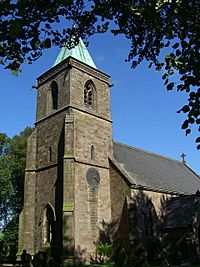Church of St Luke, Sheen, Staffordshire facts for kids
Quick facts for kids Church of St Luke, Sheen |
|
|---|---|

"Pevsner's last building"
|
|
| Lua error in Module:Location_map at line 420: attempt to index field 'wikibase' (a nil value). | |
| OS grid reference | SK113615 |
| Location | Sheen, Staffordshire |
| Country | England |
| Denomination | Church of England |
| History | |
| Dedication | Saint Luke |
| Architecture | |
| Heritage designation | Grade II* |
| Designated | 1 February 1967 |
| Architect(s) | William Butterfield |
| Completed | C14th, with C19th reconstruction |
| Administration | |
| Deanery | Alstonfield Deanery |
| Diocese | Diocese of Lichfield |
The Church of St Luke in Sheen, Staffordshire is a very old and special church. It is an Anglican church, which means it belongs to the Church of England. This building is so important that it is a Grade II* listed building.
The church was first built way back in the 14th century. But it was mostly rebuilt in the middle of the 19th century. Two architects worked on it: C. W. Burleigh and then William Butterfield. The Church of St Luke and its nearby parsonage (the house for the church's priest) were the very last buildings that a famous expert named Nikolaus Pevsner wrote about. He finished his huge "Buildings of England" book series in 1974 with the volume about Staffordshire.
History of the Church
The Church of St Luke was originally built in the 1300s. A big project to rebuild parts of the church started in 1850. A local architect named C. W. Burleigh from Leeds began the work.
However, Burleigh was soon replaced by a more famous architect, William Butterfield. This change happened because of Alexander Beresford Hope, who was a very important person connected to the church.
Beresford Hope was interested in a religious movement called Tractarianism. In 1851, he asked his friend Benjamin Webb to become the church's priest. Webb was not sure about taking the job because the area was quite remote. He eventually left in 1862. T. E. Heygate, who had been an assistant priest since 1851, took his place.
A Famous Visitor
On October 6, 1970, a Tuesday morning, Nikolaus Pevsner visited the church. He was with a journalist named Geoffrey Moorhouse. Pevsner had started his "Buildings of England" book series in 1945. The first book, about Cornwall, came out in 1951.
By the time he arrived in Sheen, he had already written 45 books! This visit was to finish the very last book in the series, which was about Staffordshire. Moorhouse wrote about their visit in an article for The Observer newspaper. It was published on October 10, 1970, and was called "Pevsner's Last Building."
Pevsner himself wrote about his thoughts on Butterfield's parsonage. He also shared his general ideas about Victorian architecture in his notes for Sheen. Today, the Church of St Luke is still an active church. It is part of the Diocese of Lichfield.
What the Church Looks Like
The Church of St Luke is built from strong, coursed stone. It has a tall tower with a pointed, pyramidal roof. The church also has a main area called the nave, a special part for the altar called the chancel, a room for the priest's robes called a vestry, and a covered entrance called a porch.
The whole church is built in a style known as Pointed Gothic. This style is known for its pointed arches and tall, grand designs. As mentioned, the church is a Grade II* listed building. This means it is a very important historic building.
The parsonage, the house next to the church, is also a Grade II* listed building. Pevsner described it as "personal and forceful," meaning it had a strong and unique design. When Pevsner and Moorhouse visited, the parsonage was empty and boarded up. But since then, it has been repaired and looks much better.
See also
- Grade II* listed buildings in Staffordshire Moorlands
- Listed buildings in Sheen, Staffordshire

